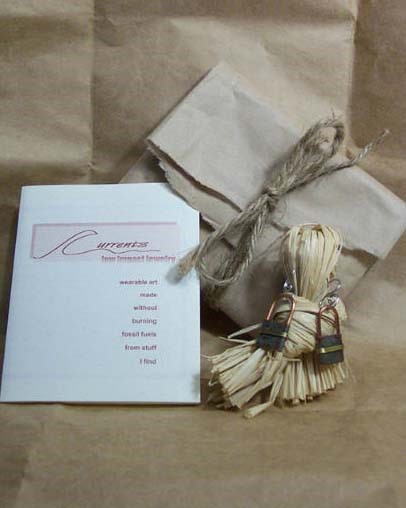by guest blogger Mckenna Hallet
Transform shoppers into customers using these strategies.

Example of packaging and fold-out “story card” used by Mckenna Hallett in her handmade jewelry business on Maui.
With all the competition online, turning a shopper into a buyer seems to get harder every day. If you are an artist selling online, it’s hard enough to get traffic to your site. Let’s look at how to convert a looker into a buyer.
One way to stand out is to employ the somewhat elusive strategy of adding value. Designed to entice, this is adding something that makes them say, “Wow, this is great. I want to buy this.”
It’s kind of the “straw that breaks the camel’s back” but in a good way. I am advocating solving some of the common pain points that your buyer may have, and giving them a cure, or thrilling them with an extra perk.
For example, if you are selling two-dimensional work, you may include the hardware they need so they can hang their new purchase without a visit to a store. You might even include some tips and hints for them; kind of a “hanging art for dummies” instructional sheet.
However, these free gifts should not be a surprise. Announce them as special bonuses to your potential buyer with a megaphone! They may not have even realized this was a potential pain point, until you made it clear that it’s included in the shipment. By simply saving them a trip to the hardware store (even though they hadn’t considered a need to do that originally) they may be motivated to hit that buy button or hand over their credit card.
There are many other inexpensive ways to woo and convert lookers into buyers for any number of different products:
- Using unique packaging
- Offering to gift-wrap items
- Including written care instructions
- Including an artist statement and/or bio
For expensive purchases, you can create accompanying keepsakes for increasing significance and importance. These take a little planning or extra effort:
- Create a hardcover coffee table book (use sites like Picaboo, Blurb, or Shutterfly) with start to finish photos of the stages of the creation of the fine art piece for the future collector. This clearly involves pre-planning and would be offered only with an heirloom quality art purchase.
- A small original pencil sketch or study that is suitable to frame
- An easel or pedestal
- A brass plaque to affix to the easel or pedestal
- If appropriate to your medium, include a coupon for a discount towards the next purchase
- A set of notecards
Depending on your medium, you may have many other ways to add value to a purchase of your art. Whatever your price points, there are likely things you can add that will make purchasing your art irresistible for the collector and give them the excuse to say “Yes.”
Then, whether you’re presenting in person or online, make certain that they know all the details. Online, make it clear up front.
In person, keep these special extra goodies as part of the recapping of benefits, not all up front. If someone is truly considering your $5000 marble sculpture, the coffee table book should be introduced eventually as additional enticement, not as an up front reason for a purchase.
In other words, resist the temptation to blurt out, “This sculpture is Italian Carrara Marble and it comes with a book that chronicles the creation.” Keep the special additions special – like a crescendo.
Consider pulling the book out to share some of the photos and then, especially if they show great interest in the book, you can announce “I include this book when you purchase. In fact, you can take this with you and enjoy it until your shipment arrives.”
Today’s buyers, especially those who are buying art, need to feel less like a buyer and more like a savvy and beloved customer. With offers coming from every corner of the internet, you can make them feel like you are offering them something they can’t get from the giant sites.
In addition, however small your gesture, this is gigantic in the overall consumer experience.
Do you have any special bonuses you include with your purchases? Please share them in the comments.


I offer my customers who spend $100 or more at my shows, a free monogrammed tote bag.
That’s great, Nancy. That’s a good example of what’s known as an incentive. Incentives are another tool that can help add value but based solely on meeting a specific condition: like buy-one-get-one-free. That’s also an incentive.
In your case, with jewelry, an example of “added value” would be that you offer free restringing for the first 5 years. Or you include a velvet pouch for storing the jewelry. Or a certificate of authenticity and/or a free appraisal for insurance purposes for more expensive pieces that utilize exotic stones.
All of those “value” adding ideas also increase the likelihood that your jewelry will be considered a great gift, too.
Thank you McKenna, you’ve really got me thinking of some ways I can add more bonuses for my collectors. I already have a special VIP discount offer for purchasing more than one artwork as well as greeting cards and a Certificate of Authenticity.
We also offer a free hanging service for local buyers.